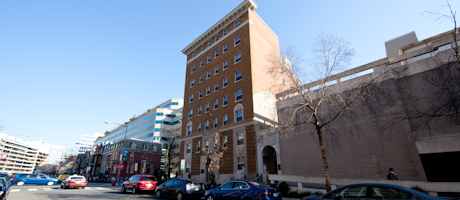GW’s Lafayette Hall, located at 2100 Eye Street, NW, has become the third GW residence hall and the first GW major renovation to receive Leadership in Energy and Environmental Design (LEED) Gold certification.
Major renovation of Lafayette Hall, which was built in 1926, began in summer 2010 and was completed a year later. The building has 69 double rooms with adjoining bathrooms on eight residential floors, plus a laundry room and study space.
“We’re especially pleased to have our third LEED Gold residence hall—along with South Hall and West Hall, both certified in 2010—to ensure the highest-quality living environment for our students,” said Nancy Giammatteo, director of facilities planning and design.
Ms. Giammatteo described some of the important “green” features of the building, including an energy-efficient roof, windows, walls, and insulation and water-efficient plumbing fixtures; natural daylight and views for residents; thermal controls for all occupants; low-volatile organic compound (VOC) interior finishes (including carpet and paint) to reduce odor and irritants; and green housekeeping practices. The building also was tested and certified to meet Environmental Protection Agency (EPA) indoor-air quality standards prior to occupancy.
In addition, Lafayette has a “white” roof made of light-colored material that reflects sunlight and helps combat the “heat-island effect” common in urban environments. The building’s landscaping uses native and adaptive plants, eliminating the need for a permanent in-ground irrigation system and further reducing the consumption of potable water.
Freshman Greg Lidrbauch is a Lafayette Hall resident and an “Eco Rep”—a student who works with Campaign GW and university staff members to coordinate programming and informational initiatives to help increase sustainable habits and lifestyles in the residence halls.
“As an incoming freshman looking at schools, one important consideration to me was the length the university went to to actually be, and not just appear, ‘green,’” he said. “As a resident of Lafayette hall, I can say that the fact that the building is LEED certified only enhances the living experience, and complements the initiatives already in place within GW to reduce water and energy use.”
Director of GW’s Office of Sustainability Meghan Chapple-Brown said every campus building in which green features are added is an important step toward a more sustainable campus.
“We are thrilled that another residence hall on GW’s campus earned LEED Gold certification. We applaud the entire team that worked to make this a reality,” Ms. Chapple-Brown said. “LEED buildings play a key role in helping GW reduce its electricity and water use, and help to enhance the university’s overall sustainability footprint. I'd like to commend the design and construction team in the Division of Operations for their tireless work on greening this extensive renovation.”


